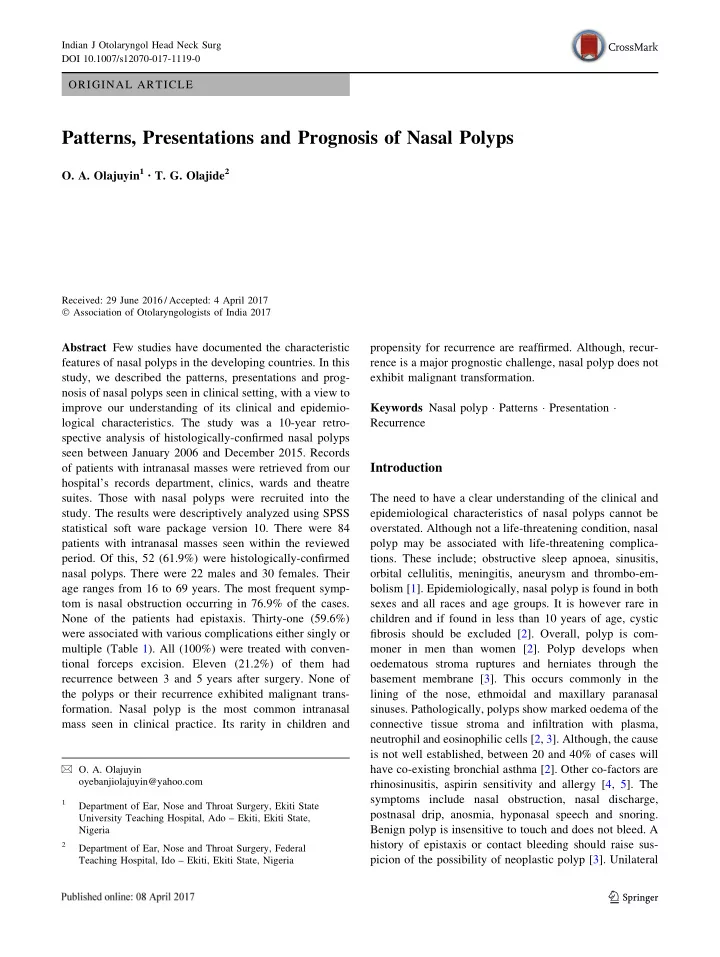

Indian J Otolaryngol Head Neck Surg DOI 10.1007/s12070-017-1119-0 ORIGINAL ARTICLE Patterns, Presentations and Prognosis of Nasal Polyps O. A. Olajuyin 1 • T. G. Olajide 2 Received: 29 June 2016 / Accepted: 4 April 2017 � Association of Otolaryngologists of India 2017 Abstract Few studies have documented the characteristic propensity for recurrence are reaffirmed. Although, recur- features of nasal polyps in the developing countries. In this rence is a major prognostic challenge, nasal polyp does not study, we described the patterns, presentations and prog- exhibit malignant transformation. nosis of nasal polyps seen in clinical setting, with a view to improve our understanding of its clinical and epidemio- Keywords Nasal polyp � Patterns � Presentation � logical characteristics. The study was a 10-year retro- Recurrence spective analysis of histologically-confirmed nasal polyps seen between January 2006 and December 2015. Records Introduction of patients with intranasal masses were retrieved from our hospital’s records department, clinics, wards and theatre suites. Those with nasal polyps were recruited into the The need to have a clear understanding of the clinical and study. The results were descriptively analyzed using SPSS epidemiological characteristics of nasal polyps cannot be statistical soft ware package version 10. There were 84 overstated. Although not a life-threatening condition, nasal patients with intranasal masses seen within the reviewed polyp may be associated with life-threatening complica- period. Of this, 52 (61.9%) were histologically-confirmed tions. These include; obstructive sleep apnoea, sinusitis, nasal polyps. There were 22 males and 30 females. Their orbital cellulitis, meningitis, aneurysm and thrombo-em- age ranges from 16 to 69 years. The most frequent symp- bolism [1]. Epidemiologically, nasal polyp is found in both tom is nasal obstruction occurring in 76.9% of the cases. sexes and all races and age groups. It is however rare in None of the patients had epistaxis. Thirty-one (59.6%) children and if found in less than 10 years of age, cystic were associated with various complications either singly or fibrosis should be excluded [2]. Overall, polyp is com- multiple (Table 1). All (100%) were treated with conven- moner in men than women [2]. Polyp develops when tional forceps excision. Eleven (21.2%) of them had oedematous stroma ruptures and herniates through the recurrence between 3 and 5 years after surgery. None of basement membrane [3]. This occurs commonly in the the polyps or their recurrence exhibited malignant trans- lining of the nose, ethmoidal and maxillary paranasal formation. Nasal polyp is the most common intranasal sinuses. Pathologically, polyps show marked oedema of the mass seen in clinical practice. Its rarity in children and connective tissue stroma and infiltration with plasma, neutrophil and eosinophilic cells [2, 3]. Although, the cause is not well established, between 20 and 40% of cases will & O. A. Olajuyin have co-existing bronchial asthma [2]. Other co-factors are oyebanjiolajuyin@yahoo.com rhinosinusitis, aspirin sensitivity and allergy [4, 5]. The symptoms include nasal obstruction, nasal discharge, 1 Department of Ear, Nose and Throat Surgery, Ekiti State postnasal drip, anosmia, hyponasal speech and snoring. University Teaching Hospital, Ado – Ekiti, Ekiti State, Benign polyp is insensitive to touch and does not bleed. A Nigeria history of epistaxis or contact bleeding should raise sus- 2 Department of Ear, Nose and Throat Surgery, Federal picion of the possibility of neoplastic polyp [3]. Unilateral Teaching Hospital, Ido – Ekiti, Ekiti State, Nigeria 123
Indian J Otolaryngol Head Neck Surg Table 1 Showing frequency distribution of the presenting complaints, radiological findings and complications Variable Frequency % Presenting complaints Nasal obstruction 40 76.9 Snoring 32 61.5 Visible nasal mass 25 48.1 Nasal discharge (watery, mucous, purulent) 14 26.9 Paroxysmal sneezing 10 19.2 Loss of sense of smell 9 17.3 Headache 8 15.4 Facial pain 5 9.6 Radiological findings Opacification of ethmoid and maxillary sinuses 46 88.5 Soft tissue opacity in the nasal cavity 41 78.9 Soft tissue opacity in the nasopharynx 26 50.0 Dome-shaped soft tissue opacity in the maxillary sinus 12 23.1 Fluid level in the maxillary sinus 6 11.5 Clear paranasal sinuses 4 7.7 Complications Acute rhinosinusitis 5 9.6 Epiphora 6 11.5 Anosmia 9 17.3 Obstructive sleep apnoea 28 53.8 Some patients have multiple complaints/radiological findings/complications polyp is rare and associated with a range of conditions that Patients and Methods needed further investigations both in adults and children [2]. Anatomically, polyp may be described as Ethmoidal or Study Setting Antrochoanal [6, 7], depending on the site and location of the polyp. Imaging studies are essential in the determina- The study was conducted in two tertiary hospitals (Ekiti tion of the site and extent in the nose and paranasal sinuses State University Teaching Hospital, Ado – Ekiti and Fed- and to rule out sinister nasal conditions. The treatment can eral Teaching Hospital, Ido – Ekiti), the only centers with be medical and/or surgical. The use of corticosteroid nose Otolaryngological services in the study area. The hospitals drops or sprays has been found useful in some patients also receive referrals from public and private hospitals [8, 9]. Other therapeutic methods are short course oral within the state and from neighboring towns in other steroids [10] and intrapolyp steroid injection [11]. The adjoining states. surgical techniques vary from the use of old-fashioned snare to modern day endoscope [12, 13]. Recurrence fol- Study Design and Data Collection lowing surgery however is a great therapeutic challenge [1–3, 14]. In clinical setting, polyp must be differentiated Records of patients with intranasal masses were retrieved from inverted papillomas, encephalocoeles, carcinoma, from the record departments of the hospitals, clinics, wards sarcomas and angiofibromas. Although widely reported by and theatre suites. Patients with histologically-confirmed foreign authors, there is scant publication on the subject nasal polyps were recruited into the study. The information from this part of the world. Thus, we embarked on this extracted from their case files were biodata, presenting study to document our own experience and improve our complaints at first attendance, duration of symptoms, evi- understanding of its clinical and epidemiological dence of allergy, X-ray findings, histological features, characteristics. treatment and outcome. 123
Recommend
More recommend